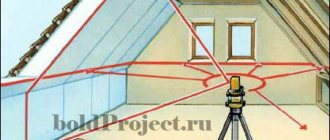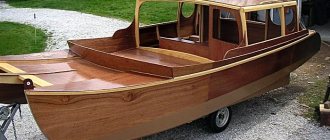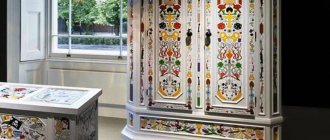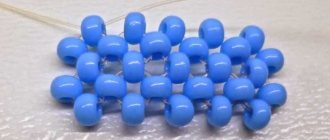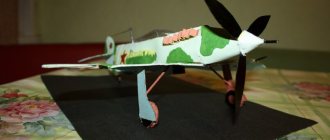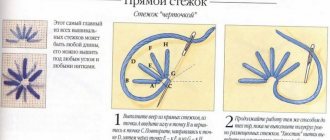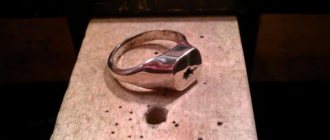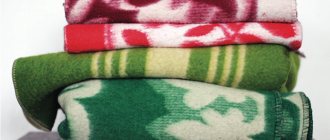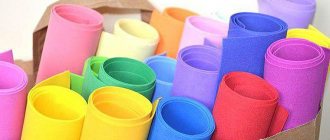Hacksaw blade cutter
With its help, you can make a board without etching, separating the tracks that are not connected to each other by a groove cut in the PCB foil. This method is available, if, of course, the board is simple enough. Also, when repairing or making changes to the device circuit, sometimes it is necessary to cut the tracks on the printed circuit board. A cutter is also used for this purpose.
Fluxing or tinning
When soldering, the main thing is to ensure good contact between the parts being soldered. To do this, before starting soldering, the parts to be joined must be tinned or treated with flux. These two processes are interchangeable. Their main purpose is to improve the quality of the connection and facilitate the process itself.
The soldering process begins with tinning the wires
Tinning
To process the wires you will need a well-heated soldering iron, a piece of rosin, and a small amount of solder.
We take the stripped wire, lay it on rosin, and heat it with a soldering iron. While warming up, we turn the conductor. When the wire is completely covered in molten rosin, put a little solder on the soldering iron tip (just touch it with the tip). Then we remove the wire from the rosin and run the tip of the tip along the exposed conductor.
Tinning wires is a mandatory step when soldering
In this case, the solder covers the metal with a thin film. If it is copper, it turns from yellow to silver. The wire also needs to be turned a little, and the tip must be moved up/down. If the conductor is well prepared, it becomes completely silver, without gaps or yellow paths.
Flux treatment
Here everything is both simpler and more complicated. Easier in the sense that you only need the composition and a brush. Dip the brush into the flux and apply a thin layer of the compound to the soldering area. All. This is simplicity.
Difficulty in choosing flux. There are many varieties of this composition and you need to select your own for each type of work. Since we are now talking about how to properly solder wires or electronic components (boards) with a soldering iron, we will give several examples of good fluxes for this type of work:
- Borax and flux LTI-120 are suitable for soldering copper and aluminum wires.
- It is better to solder copper - POS-60, POS-50, POS-40.
- For aluminum - TsO-12, P-250A, TsA-15.
There are different fluxes, you need to select them carefully
For soldering electronic components (printed circuit boards), do not use active (acid) fluxes. Better - water or alcohol based. Acidic ones have good electrical conductivity, which can disrupt the operation of the device. They are also very chemically active and can cause destruction of insulation and corrosion of metals. Due to their activity, they prepare metals very well for soldering, so they are used if it is necessary to solder a wire to metal (the pad itself is processed). The most common representative is “Soldering Acid”.
Hot glue gun
An indispensable thing when assembling a device in a case. For example, we need to display LED indications on the front panel. If switches and variable resistors are mounted on the case, and securing them is not difficult, with LEDs everything is more complicated. It is necessary that during operation of the device, if we accidentally press on the LED, it does not recess into the housing, which will certainly happen even if we insert the LED into the hole “with tension”. And so we turn on the gun, wait 5 minutes, a drop of molten glue, which, when cooled, will firmly fix the LED, and we’re done. Such a pistol costs only 40 rubles in retail stores of Chinese goods in our city “Fix price”. The only thing is that there is no power cord at all, and after 5-10 uses it had to be replaced, but this is not a problem for us? The glue sticks themselves cost only 6 rubles per piece, and they last a long time.
Electronics kit
A very convenient and inexpensive set of tools with everything you need for soldering and repair.
The composition of the kit is very rich, see:
- soldering iron 60 W with temperature control 200 - 480 °C;
- 5 replaceable soldering tips of different shapes;
- soldering iron stand;
- solder;
- vacuum suction to remove excess solder;
- Digital multimeter is very compact and lightweight. Its capabilities are more modest than the device we described above, but everything you need is there;
- nippers (side cutters);
- screwdriver with replaceable bits;
- knife with replaceable blades;
- stripping tool;
- two tweezers;
- bag.
Of course, it cannot be said that the instrument included in this set is of ultra-high quality. But at this price it is a very good option. Thanks to the compact but roomy bag, this set is especially convenient to take with you “on the go.”
There is a good discount on this set now - 50%

